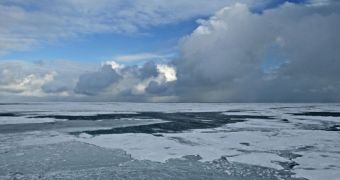The results of a new scientific investigation suggest that ice sheets at the North Pole may stabilize or even start growing again over the coming decades, even if the situation now looks rather bleak. Though the trend will only be temporary, it may give use the respite we need to take action.
Previous studies suggested that the Arctic may become ice-free by 2050, but the new work disputes this, saying that variables that were never accounted for in the past are beginning to be discovered.
At this point, ice sheets in the region are declining at an ever-accelerating pace, mostly because global warming is causing a much sharper increase in temperature at the poles than at the Equator.
This investigation was carried out by experts at the National Center for Atmospheric Research (NCAR). Details of the study appear in the latest issue of the American Geophysical Union's respected journal Geophysical Research Letters (GRL).
The NCAR team carried out the research effort with funds from the US National Science Foundation (NSF). “As we learn more about climate variability, new and unexpected research results are coming to light,” expert Sarah Ruth explains.
“What's needed now are longer-term observations to better understand the effect of climate change on Arctic sea ice,” adds Ruth, who is a program director in the NSF Division of Atmospheric and Geospace Sciences, which funds NCAR.
This research was carried exclusively on computer models. While it revealed that all the other studies were correct, and that the ice may indeed disappear from the North Pole during the summer altogether, they also showed scenarios in which the ices remain stable.
That is not to say that the eventual meltdown will not occur. What the study is suggesting is that periods in which the ices melt fast will be intertwined with periods spanning up to 10 years during which ice sheets in the Arctic may remain stable, or even grow slightly.
However, the team is adamant that current global situation cannot continue for long. In other words, the researchers are saying that we can aid nature in keeping the polar ice sheet steady if we cut back on greenhouse gas emissions, especially carbon dioxide and methane.
“One of the results that surprised us all was the number of computer simulations that indicated a temporary halt to the loss of the ice,” NCAR scientist and lead study researcher Jennifer Kay explains.
“The computer simulations suggest that we could see a 10-year period of stable ice or even a slight increase in the extent of the ice,” she goes on to say.
“Even though the observed ice loss has accelerated over the last decade, the fate of sea ice over the next decade depends not only on human activity but also on climate variability that cannot be predicted,” the expert adds, referring to things like shifting wind patterns.
However, “when you start looking at longer-term trends, 50 or 60 years, there's no escaping the loss of ice in the summer,” Kay concludes.

 14 DAY TRIAL //
14 DAY TRIAL //